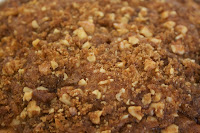 |
| Jesse Corbin, 1909 |
 |
| Corbin's New House on the Homestead Circa 1912 |
Grandma was not known for her cooking skills. As a matter of fact, I've heard it said that everyone calls this recipe "Grandma Iverson Cookies" because that was all she knew how to make. I guess if you can only do one thing, it should be good, and thankfully this is!
I likely never ate any of these cookies that were made by Grandma herself - she was probably done baking by the time I came on the scene, but many members of my family make them, each with slightly different results - all delicious! One aunt has the reputation for recreating them most accurately. There are a few theories as to why the results vary - the most plausible is that only making them by hand results in the Grandma I cookie most akin to the original. This makes sense of course because Grandma certainly didn't have a Kitchen Aid on her counter! The last time I creamed butter and sugar by hand was high school Home Ec. No thank you . . . My Grandma I cookie turns out moist, soft and chewy and pretty darn delicious if you ask me.
 GRANDMA I COOKIES
GRANDMA I COOKIES1 -2 C raisins ( I use 2)
1 C boiling water
1 tsp baking soda
2 C sugar
1 C shortening (I use butter)
3 eggs
1 tsp banilla
4 C flour
1 tsp baking powder
 1 tsp salt
1 tsp salt1 tsp cinnamon
1/4 tsp nutmeg
1 C walnuts (optional).
Preheat oven to 425 degrees.
In a smal saucepan combine water and raisins and bring to a boil over med-high heat on stovetop. Cook for five minutes. Set aside and let cool. Add baking soda, let stand.
If you're game - cream butter and sugar by hand in a mixing bowl with a wooden spoon. Otherwise, with a handheld or stand mixer, cream shortening and sugar until light and fluffy. (about 3-5 minutes with stand mixer). Add eggs one at a time until combined, add vanilla and raisins with liquid. Mix well.
Sift together flour and remaining dry ingredients. Add to shortening mixture and mix until fully incorporated. Stir in nuts if using.
 Using 1 1/2 inch scoop drop dough on parchment or Silpat lined cookie sheets two inches apart. Bake until thoroughly golden brown about 12 - 16 minutes, rotating baking sheets half way through. The cookies will start to brown quickly but don't be tempted to take them out too soon. Makes 5 dozen.
Using 1 1/2 inch scoop drop dough on parchment or Silpat lined cookie sheets two inches apart. Bake until thoroughly golden brown about 12 - 16 minutes, rotating baking sheets half way through. The cookies will start to brown quickly but don't be tempted to take them out too soon. Makes 5 dozen. |
| Space 2" apart, they will spread |
 |
| Rotate baking sheets half-way through baking |
 |
| They're done when perfectly golden all over |
 |
| Enjoy! |




































